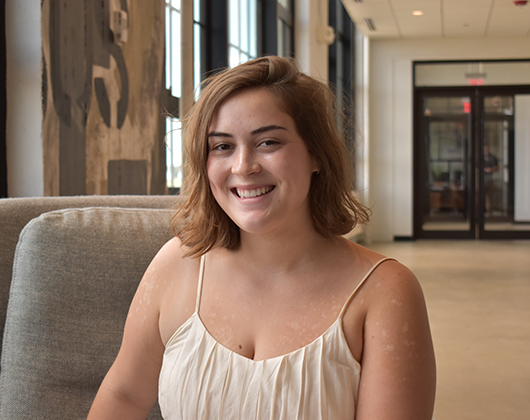Date
August 12, 2019

Iris Hazelton
What is the best advice you received?
The best advice I received was to not undersell myself as an intern and offer my voice if I have any input on a project, as it never hurts to make a suggestion. When I started as an intern at TRIA, I felt I was only here to complete menial tasks that needed to get done. I was surprised when designers asked for my opinion on projects or to pick out materials myself but grew more confident as I became more familiar with the design process. I’m grateful to those who reminded me that everyone starts somewhere, often as an intern themselves, and that its okay to still be learning the ins and outs of the field.
What is your favorite part of the job?
I really enjoyed watching the designers work, as well as being a part of the collaborative design process that takes place here at TRIA. Hearing and seeing all the different parts that go into a completed project was incredibly informative and getting to participate in these conversations was a truly valuable experience. The people who work here have such a passion for their field and produce amazing work; I was able to learn so much from working with the teams. Everything is always subject to change, and often I would see designers relying on their instincts to stay flexible and keep the project moving forward, regardless of any unforeseen events.
What is a notable challenge you faced, and how did you overcome it?
Coming into TRIA, I had little experience with the design software used throughout the firm, which limited my ability to assist with specific tasks. I was surprised to learn that much of the staff here had been able to learn the program themselves through experience as an intern and they always made the time to offer insight and assistance as I worked through the learning curve.
Has working at TRIA changed your opinion of your field of study? How?
As an art student, I’ve mostly studied architecture in the context of movements and periods that were defined by the external appearance of a structure. Seeing how art and design can be applied to the interiors has given me a more holistic understanding of the field. So many tiny details go into creating a cohesive space that is both functional and aesthetically pleasing, many of which I have only just begun to understand. Both the architecture and the design of a space influence each other: a good space has a closely linked process where neither is left to the wayside, and I have found it fascinating to witness that process. Additionally, I’ve caught myself noticing architectural and design details in my day to day life and relating it back to what I have learned here, and how I might have done it differently.
What do you wish you had more exposure to during your time here?
As my time here was relatively short, most of the projects I worked on were underway when I arrived and will still be in progress when I leave. I would’ve loved to see what the very beginning stages of a project looked like, and how the overall direction of the design was decided on. It would’ve also been great to be able to see any of the projects to completion and see how everyone’s hard work manifests itself in the final product. Hopefully, as a Boston native, I’ll get the chance to see one of the spaces sometime in the future.
What is your fondest TRIA-related memory?
I’ve really enjoyed the experience of working with the team in the satellite office on the 7th floor and have many good memories of that space. The creative energy in that environment is very strong and listening to music and chatting while we work has been a generally enjoyable experience. I also really enjoyed the screening of Jurassic Park for the fashion show project.
What is a skill you learned or honed while working at TRIA?
Besides learning Revit, I’ve been able to hone my own design skills and narrow in on an aesthetic that suits my personal style. I was always amazed when people would approach me while working on a project and could tell who had designed the space just by the look of it. It’s forced me to think about how different design factors interact, especially considering how heavily we prioritize the client’s wishes and needs, and yet a designer’s aesthetic still manages to shine through. I’ve seen the value of individualizing your work to showcase your strengths as a designer, which I believe will be crucial going forward into my career.


